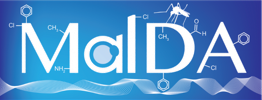Novel Antimalarial Tetrazoles and Amides Active against the Hemoglobin Degradation Pathway in .
Journal:
Journal of medicinal chemistry, Volume: 64, Issue: 5Abstract:
Malaria control programs continue to be threatened by drug resistance. To identify new antimalarials, we conducted a phenotypic screen and identified a novel tetrazole-based series that shows fast-kill kinetics and a relatively low propensity to develop high-level resistance. Preliminary structure-activity relationships were established including identification of a subseries of related amides with antiplasmodial activity. Assaying parasites with resistance to antimalarials led us to test whether the series had a similar mechanism of action to chloroquine (CQ). Treatment of synchronized parasites with active analogues revealed a pattern of intracellular inhibition of hemozoin (Hz) formation reminiscent of CQ’s action. Drug selections yielded only modest resistance that was associated with amplification of the multidrug resistance gene 1 (). Thus, we have identified a novel chemical series that targets the historically druggable heme polymerization pathway and that can form the basis of future optimization efforts to develop a new malaria treatment.
